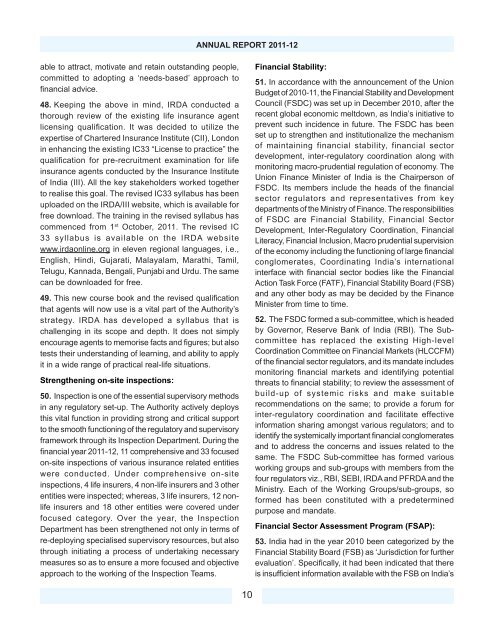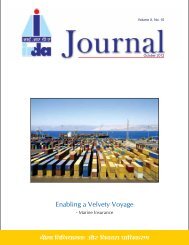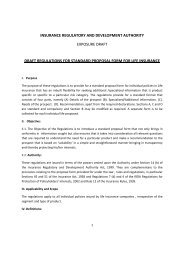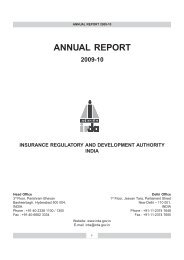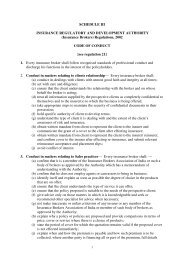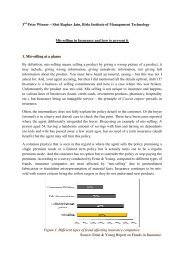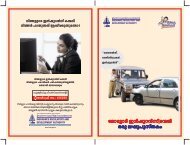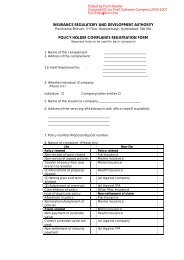Download PDF - IRDA
Download PDF - IRDA
Download PDF - IRDA
You also want an ePaper? Increase the reach of your titles
YUMPU automatically turns print PDFs into web optimized ePapers that Google loves.
ANNUAL REPORT 2011-12<br />
able to attract, motivate and retain outstanding people,<br />
committed to adopting a ‘needs-based’ approach to<br />
fi nancial advice.<br />
48. Keeping the above in mind, <strong>IRDA</strong> conducted a<br />
thorough review of the existing life insurance agent<br />
licensing qualifi cation. It was decided to utilize the<br />
expertise of Chartered Insurance Institute (CII), London<br />
in enhancing the existing IC33 “License to practice” the<br />
qualifi cation for pre-recruitment examination for life<br />
insurance agents conducted by the Insurance Institute<br />
of India (III). All the key stakeholders worked together<br />
to realise this goal. The revised IC33 syllabus has been<br />
uploaded on the <strong>IRDA</strong>/III website, which is available for<br />
free download. The training in the revised syllabus has<br />
commenced from 1 st October, 2011. The revised IC<br />
33 syllabus is available on the <strong>IRDA</strong> website<br />
www.irdaonline.org in eleven regional languages, i.e.,<br />
English, Hindi, Gujarati, Malayalam, Marathi, Tamil,<br />
Telugu, Kannada, Bengali, Punjabi and Urdu. The same<br />
can be downloaded for free.<br />
49. This new course book and the revised qualifi cation<br />
that agents will now use is a vital part of the Authority’s<br />
strategy. <strong>IRDA</strong> has developed a syllabus that is<br />
challenging in its scope and depth. It does not simply<br />
encourage agents to memorise facts and figures; but also<br />
tests their understanding of learning, and ability to apply<br />
it in a wide range of practical real-life situations.<br />
Strengthening on-site inspections:<br />
50. Inspection is one of the essential supervisory methods<br />
in any regulatory set-up. The Authority actively deploys<br />
this vital function in providing strong and critical support<br />
to the smooth functioning of the regulatory and supervisory<br />
framework through its Inspection Department. During the<br />
financial year 2011-12, 11 comprehensive and 33 focused<br />
on-site inspections of various insurance related entities<br />
were conducted. Under comprehensive on-site<br />
inspections, 4 life insurers, 4 non-life insurers and 3 other<br />
entities were inspected; whereas, 3 life insurers, 12 nonlife<br />
insurers and 18 other entities were covered under<br />
focused category. Over the year, the Inspection<br />
Department has been strengthened not only in terms of<br />
re-deploying specialised supervisory resources, but also<br />
through initiating a process of undertaking necessary<br />
measures so as to ensure a more focused and objective<br />
approach to the working of the Inspection Teams.<br />
Financial Stability:<br />
51. In accordance with the announcement of the Union<br />
Budget of 2010-11, the Financial Stability and Development<br />
Council (FSDC) was set up in December 2010, after the<br />
recent global economic meltdown, as India’s initiative to<br />
prevent such incidence in future. The FSDC has been<br />
set up to strengthen and institutionalize the mechanism<br />
of maintaining financial stability, financial sector<br />
development, inter-regulatory coordination along with<br />
monitoring macro-prudential regulation of economy. The<br />
Union Finance Minister of India is the Chairperson of<br />
FSDC. Its members include the heads of the fi nancial<br />
sector regulators and representatives from key<br />
departments of the Ministry of Finance. The responsibilities<br />
of FSDC are Financial Stability, Financial Sector<br />
Development, Inter-Regulatory Coordination, Financial<br />
Literacy, Financial Inclusion, Macro prudential supervision<br />
of the economy including the functioning of large financial<br />
conglomerates, Coordinating India’s international<br />
interface with fi nancial sector bodies like the Financial<br />
Action Task Force (FATF), Financial Stability Board (FSB)<br />
and any other body as may be decided by the Finance<br />
Minister from time to time.<br />
52. The FSDC formed a sub-committee, which is headed<br />
by Governor, Reserve Bank of India (RBI). The Subcommittee<br />
has replaced the existing High-level<br />
Coordination Committee on Financial Markets (HLCCFM)<br />
of the financial sector regulators, and its mandate includes<br />
monitoring fi nancial markets and identifying potential<br />
threats to fi nancial stability; to review the assessment of<br />
build-up of systemic risks and make suitable<br />
recommendations on the same; to provide a forum for<br />
inter-regulatory coordination and facilitate effective<br />
information sharing amongst various regulators; and to<br />
identify the systemically important financial conglomerates<br />
and to address the concerns and issues related to the<br />
same. The FSDC Sub-committee has formed various<br />
working groups and sub-groups with members from the<br />
four regulators viz., RBI, SEBI, <strong>IRDA</strong> and PFRDA and the<br />
Ministry. Each of the Working Groups/sub-groups, so<br />
formed has been constituted with a predetermined<br />
purpose and mandate.<br />
Financial Sector Assessment Program (FSAP):<br />
53. India had in the year 2010 been categorized by the<br />
Financial Stability Board (FSB) as ‘Jurisdiction for further<br />
evaluation’. Specifi cally, it had been indicated that there<br />
is insufficient information available with the FSB on India’s<br />
10


